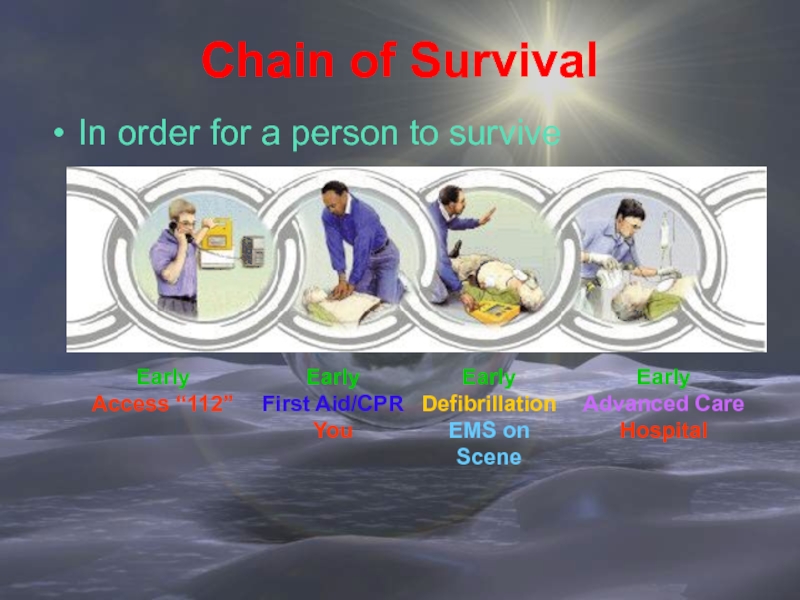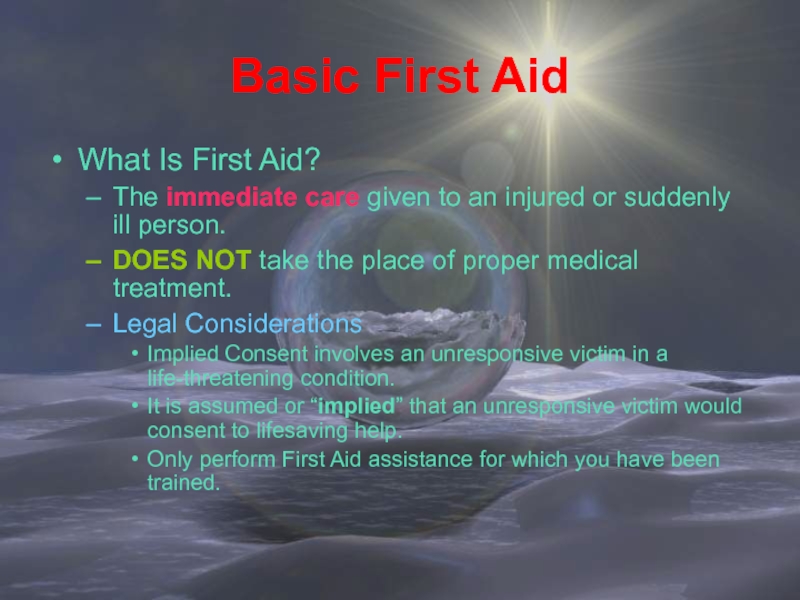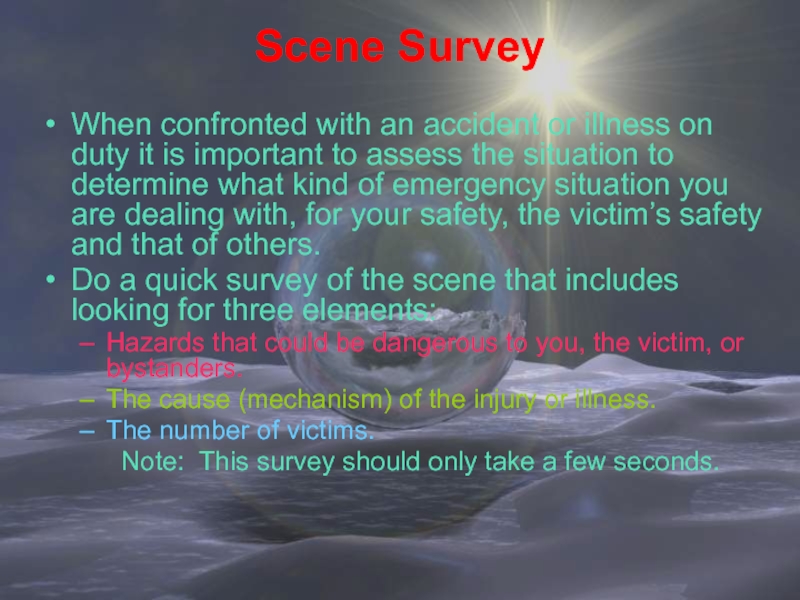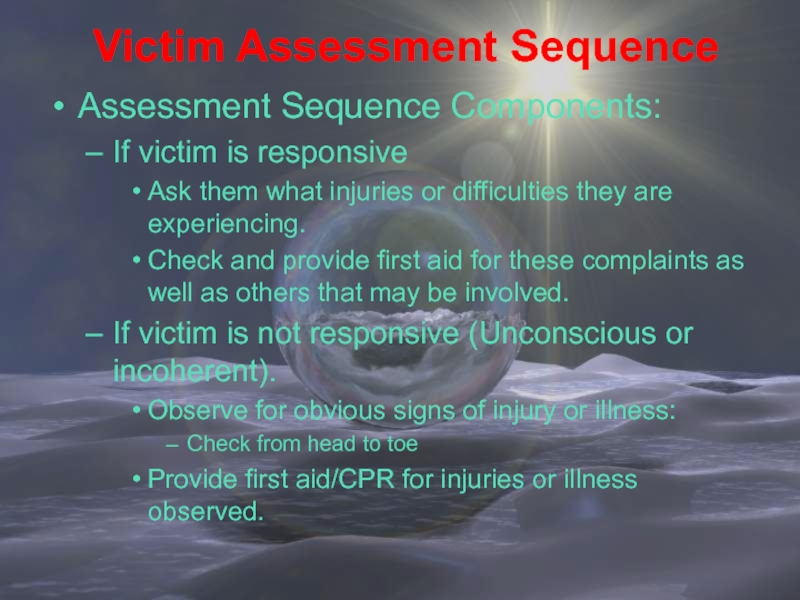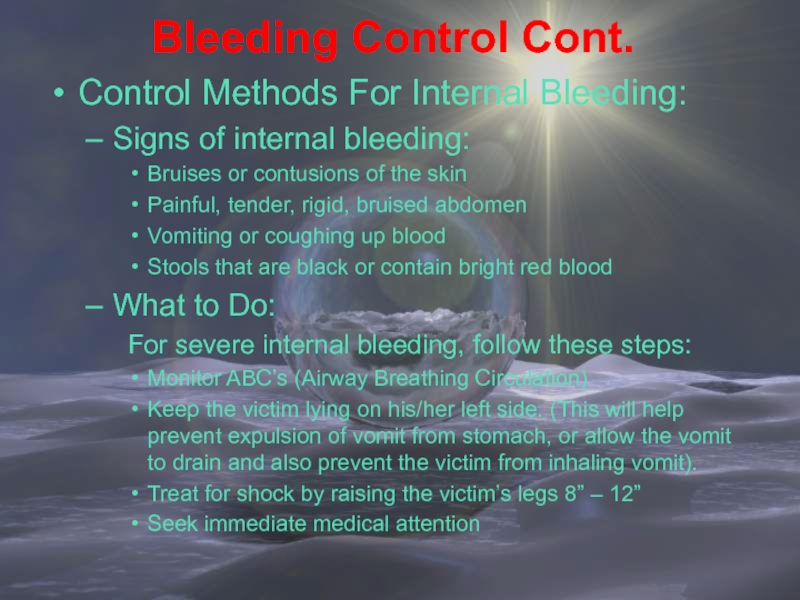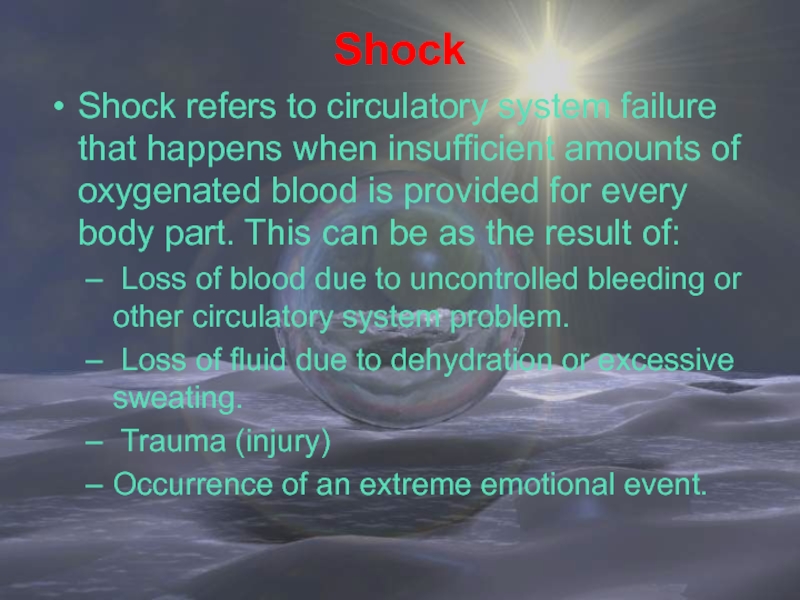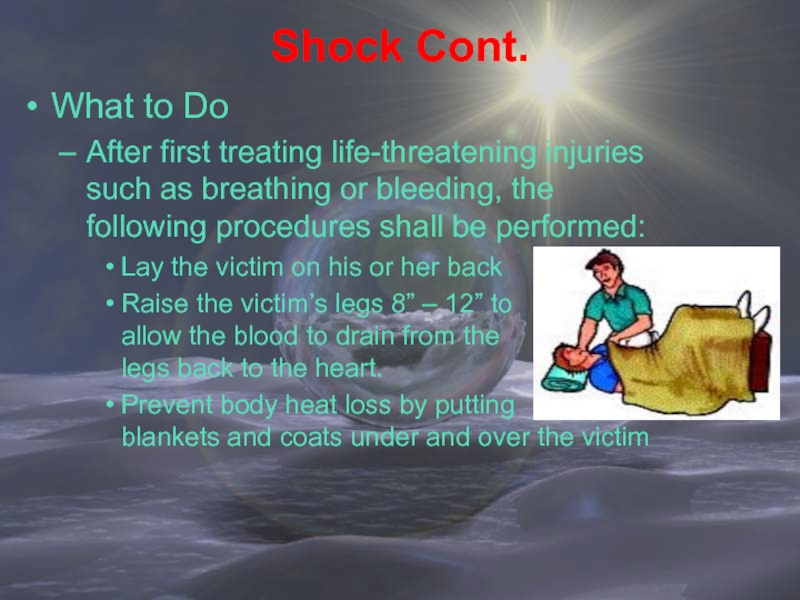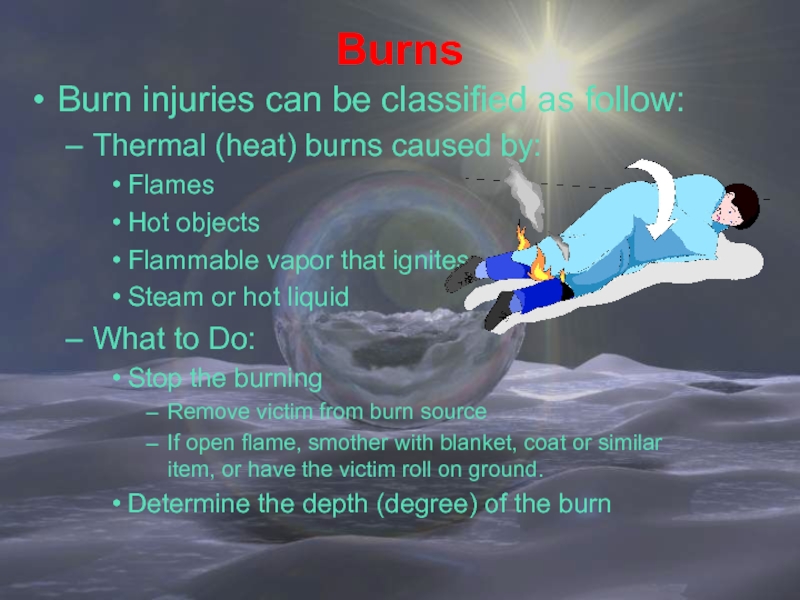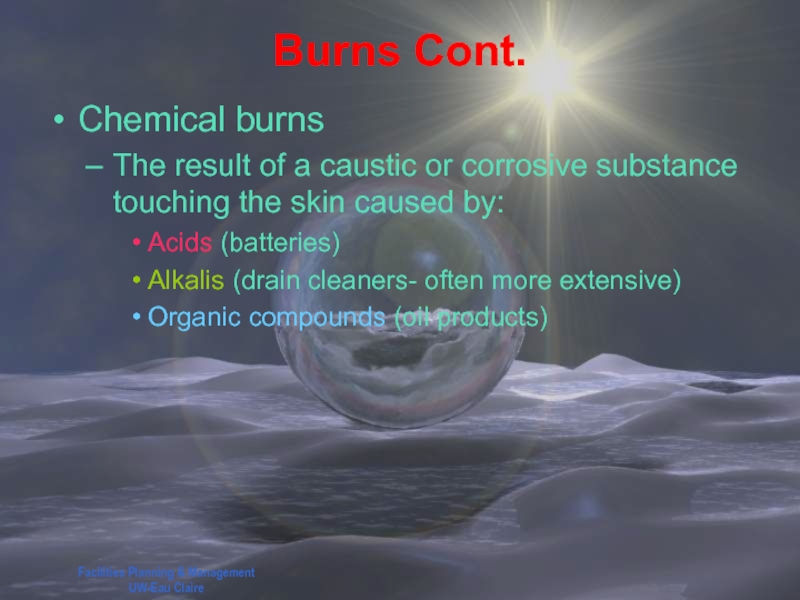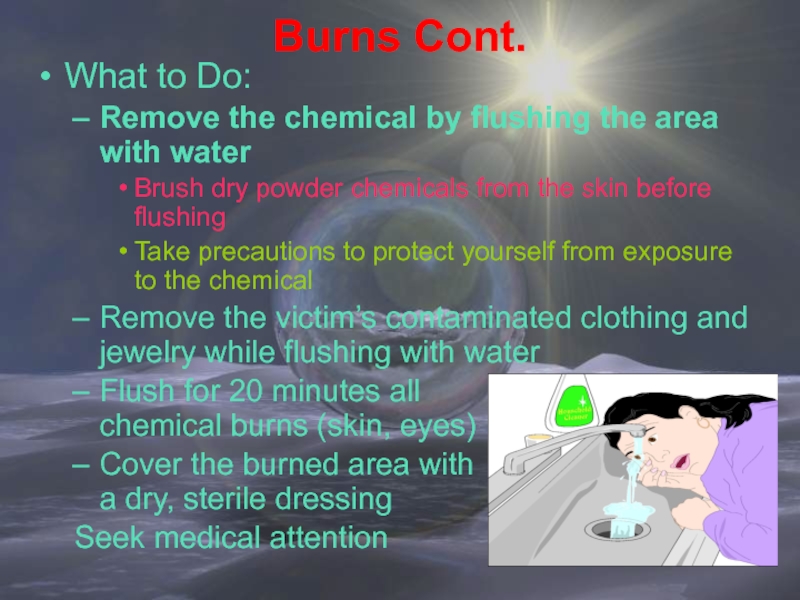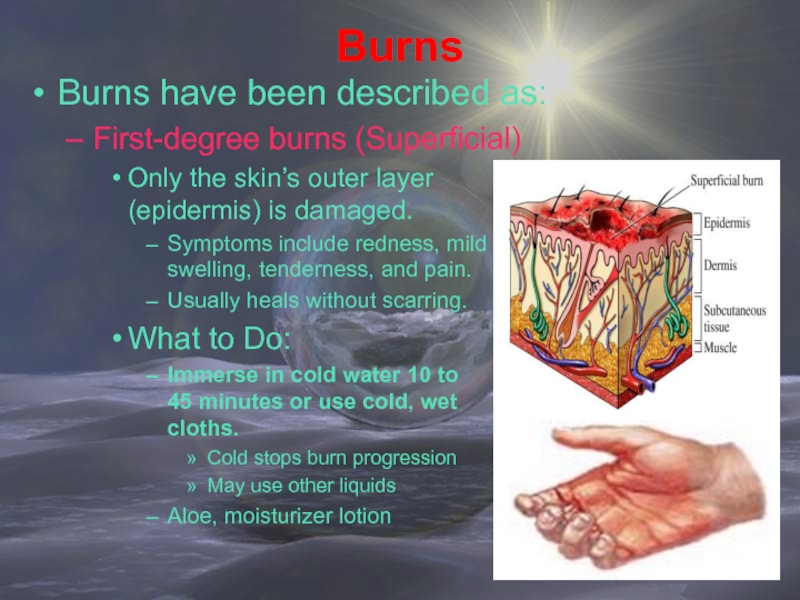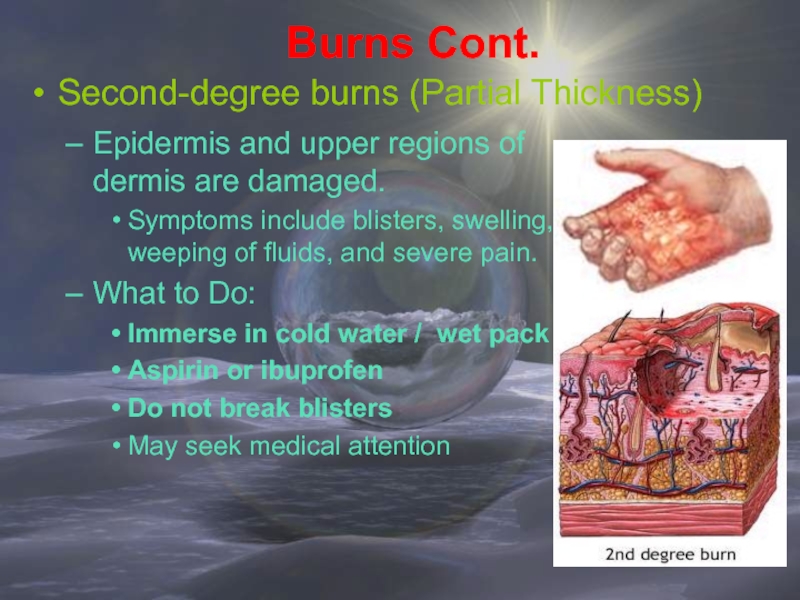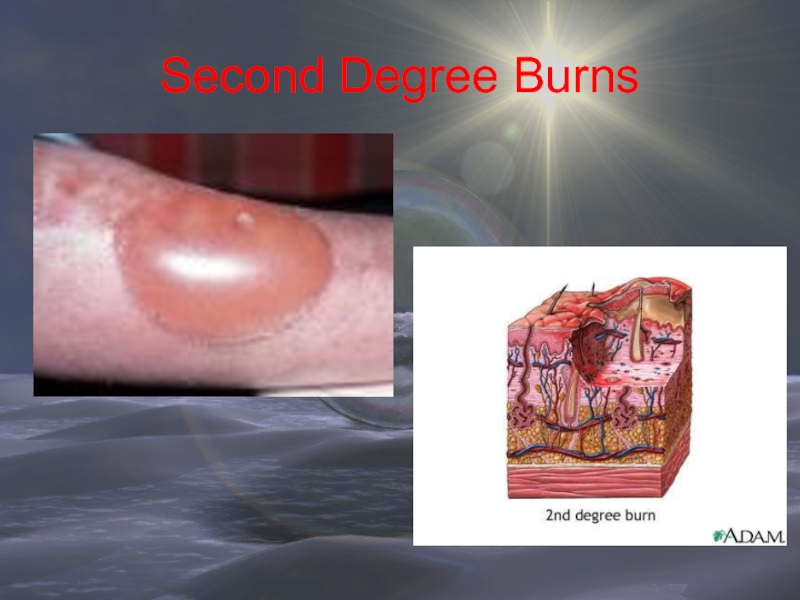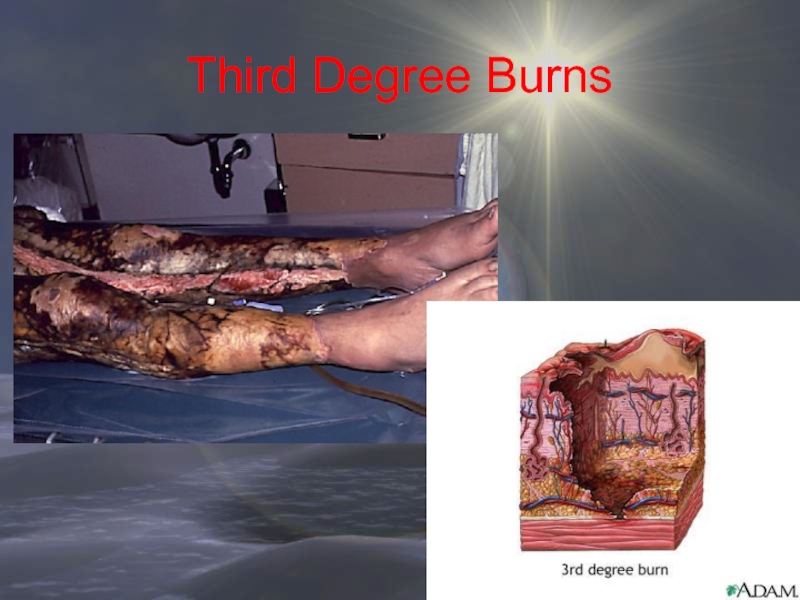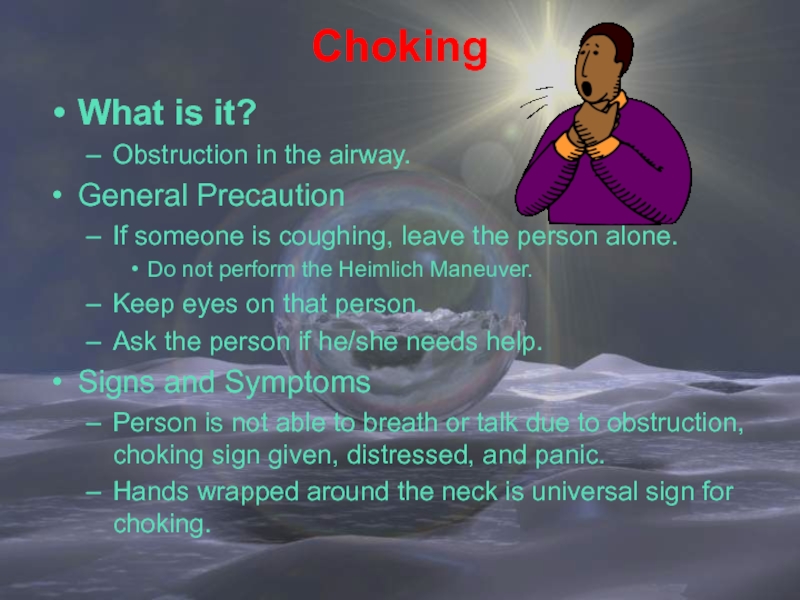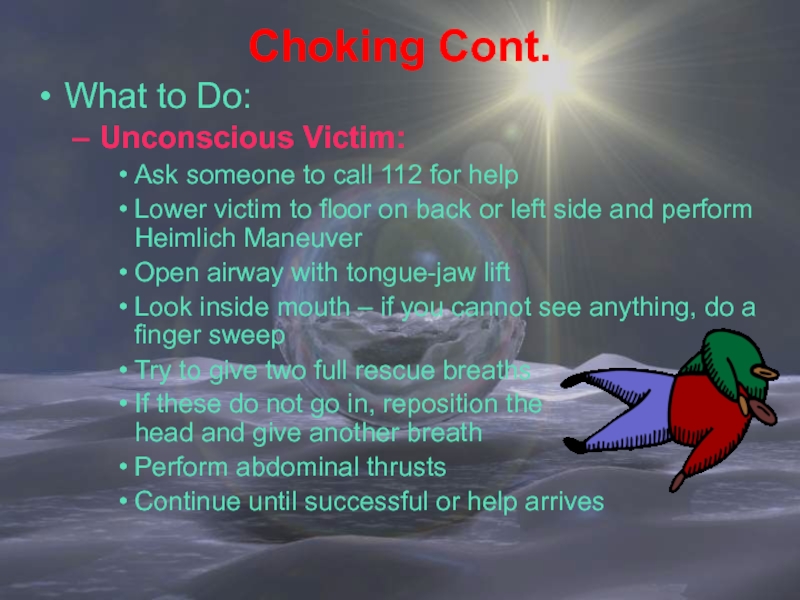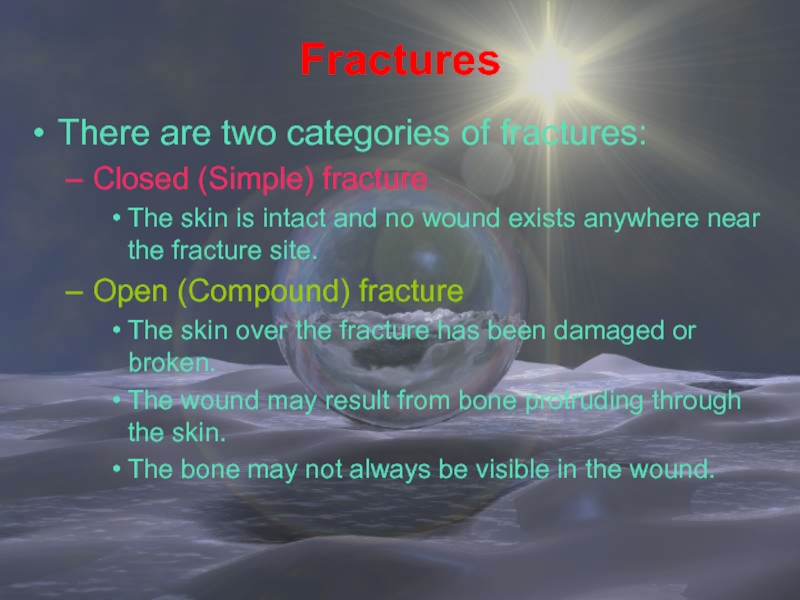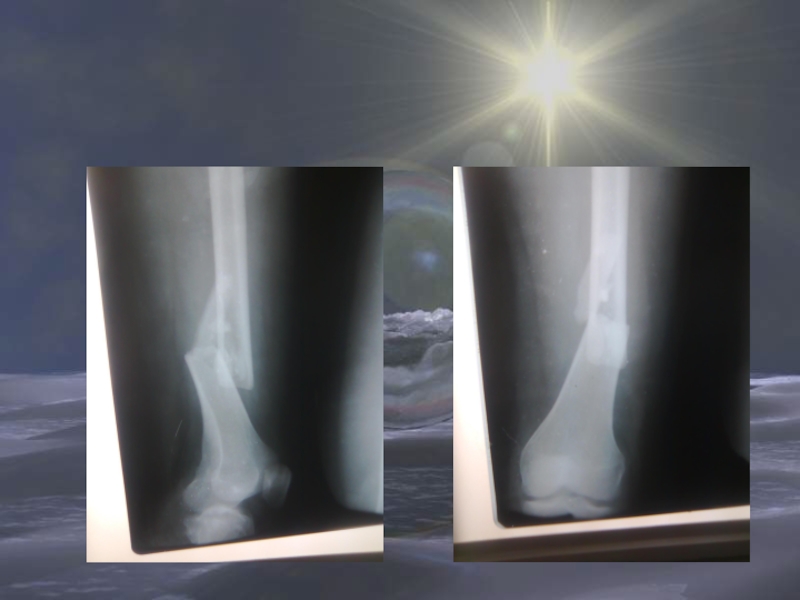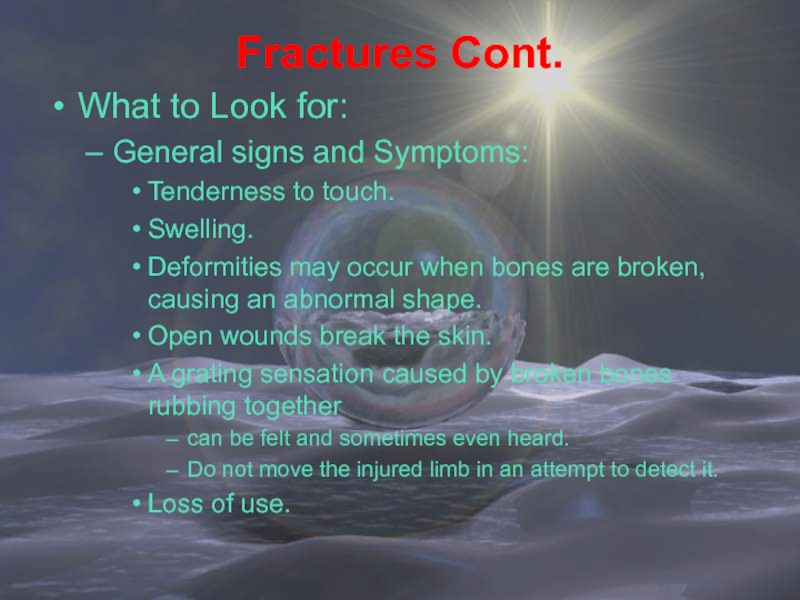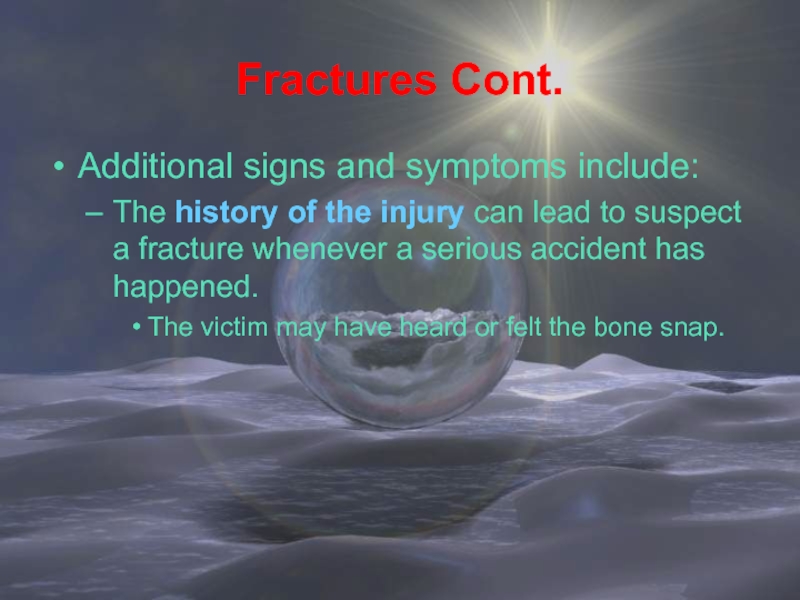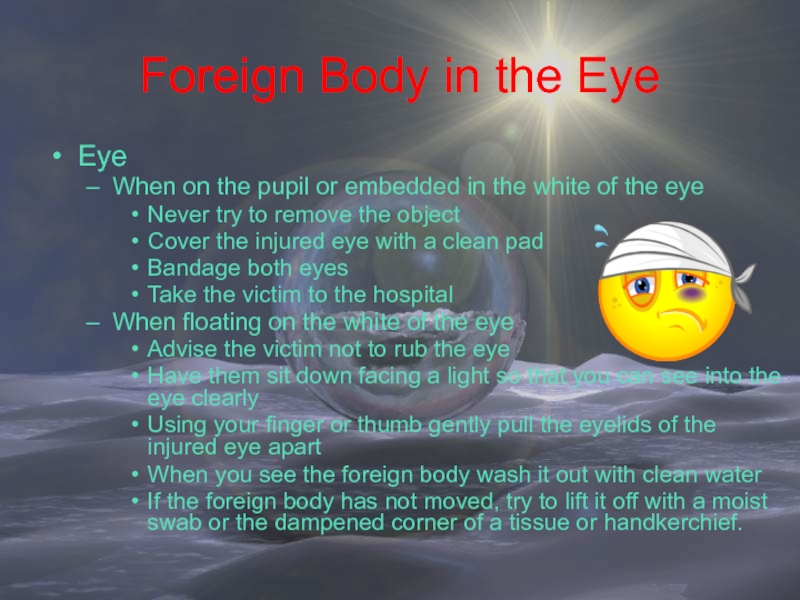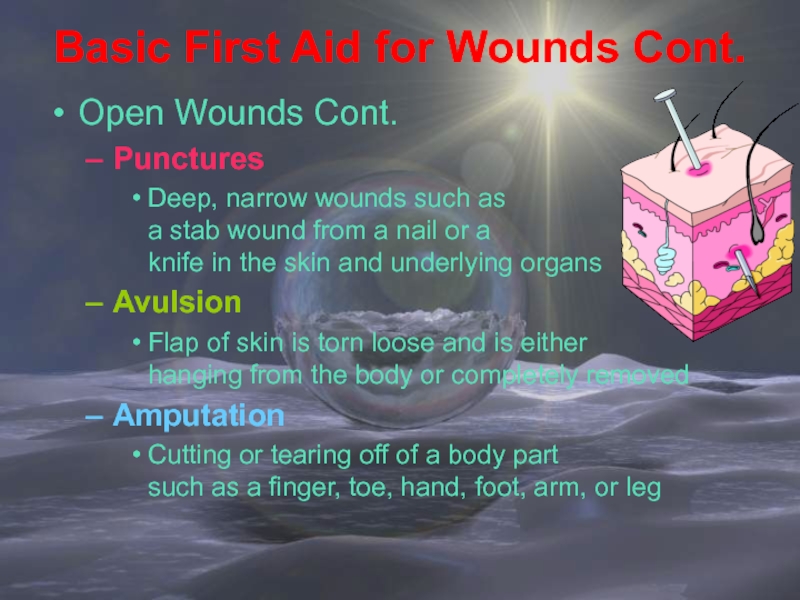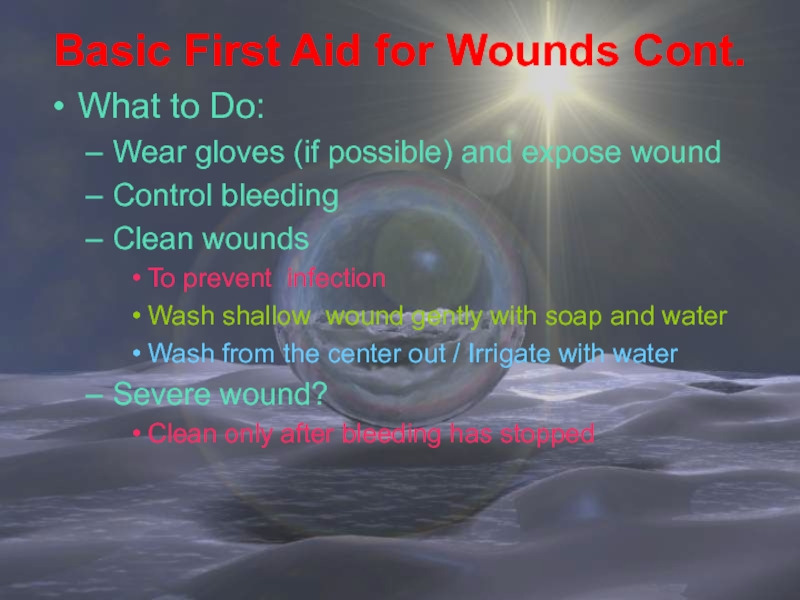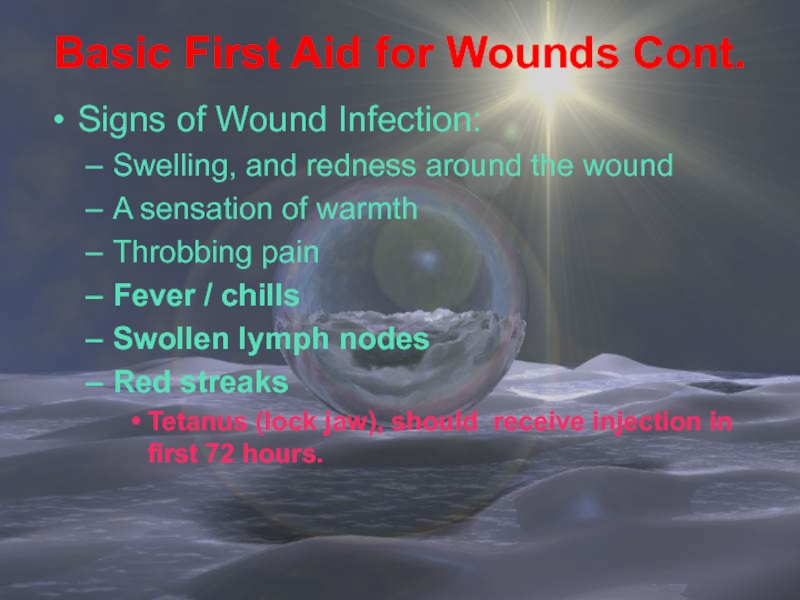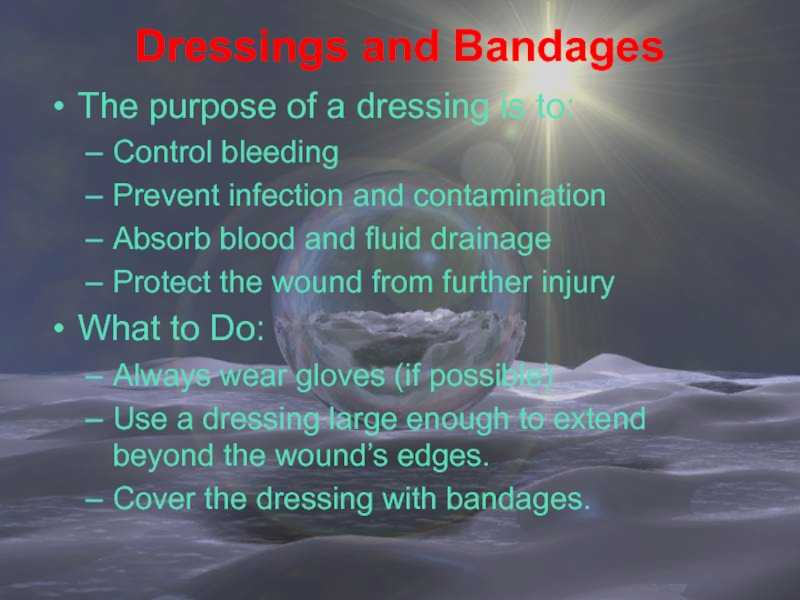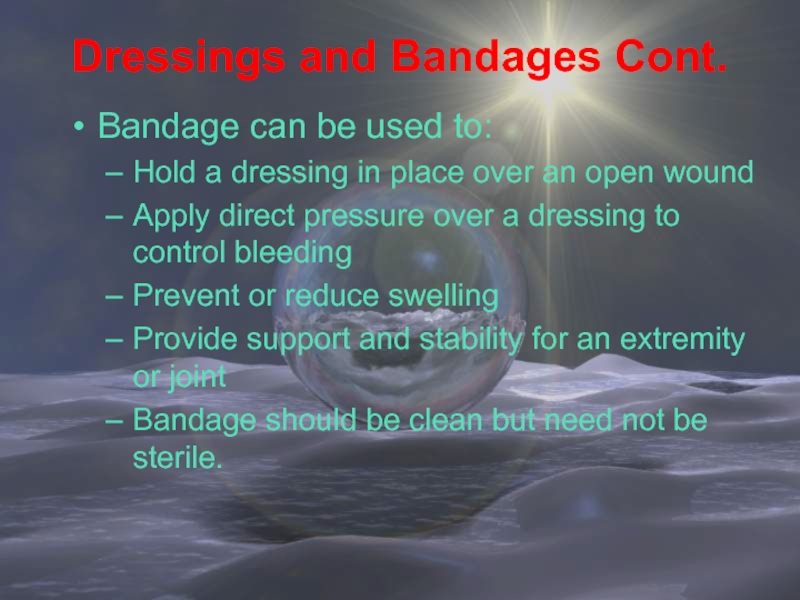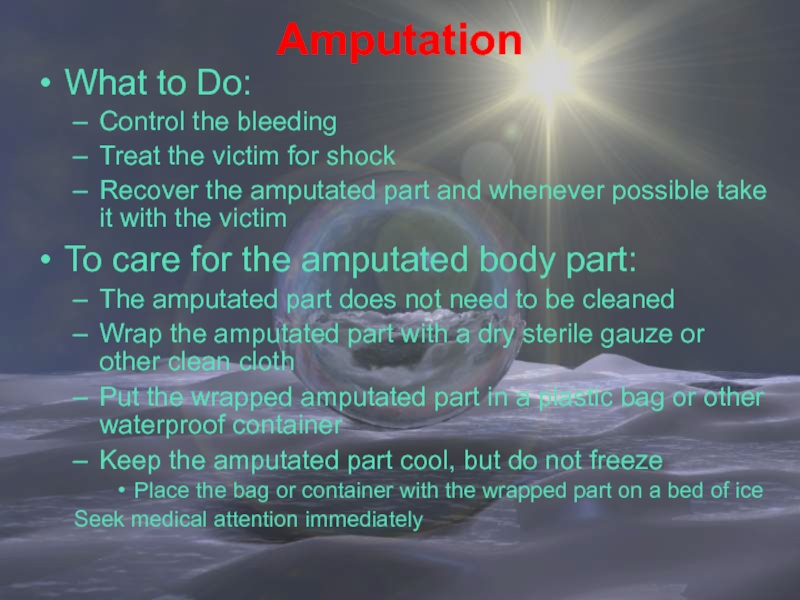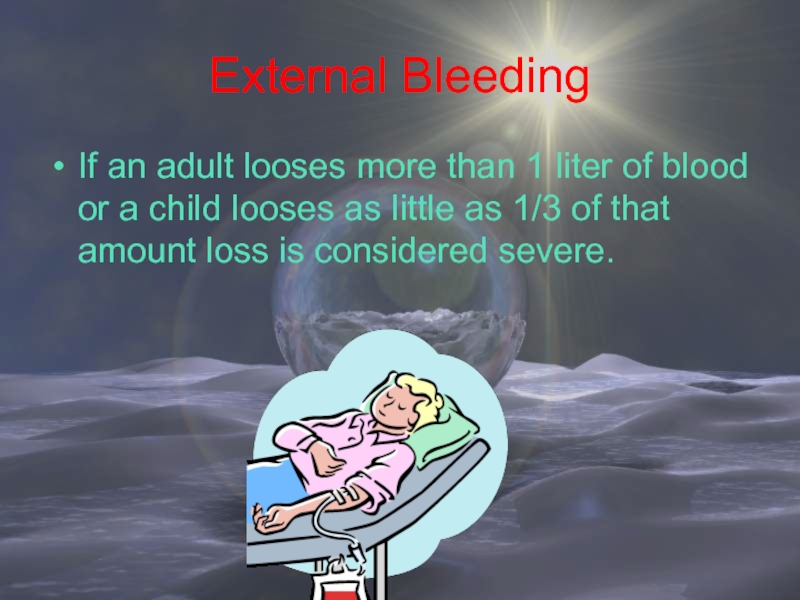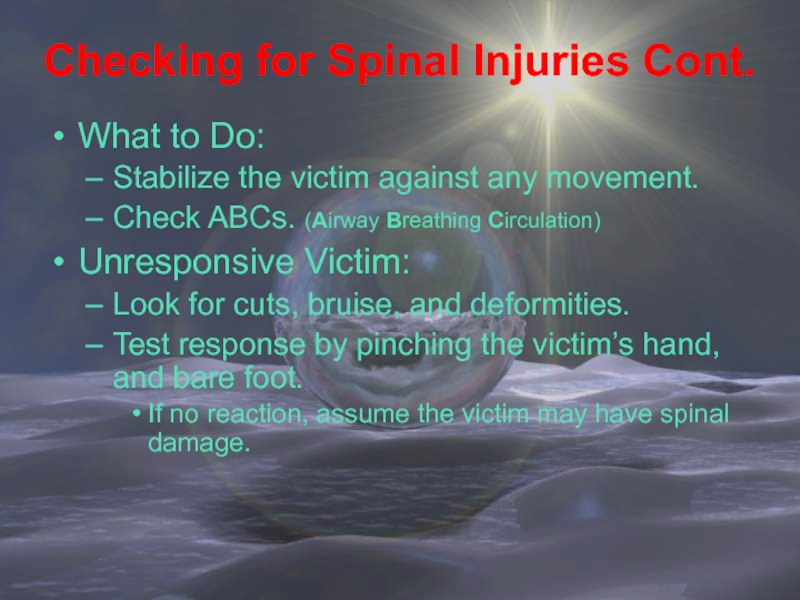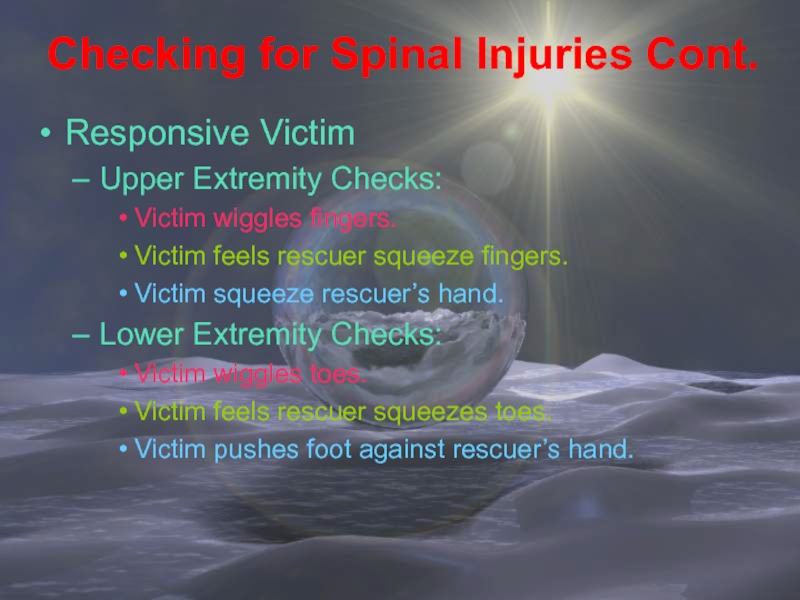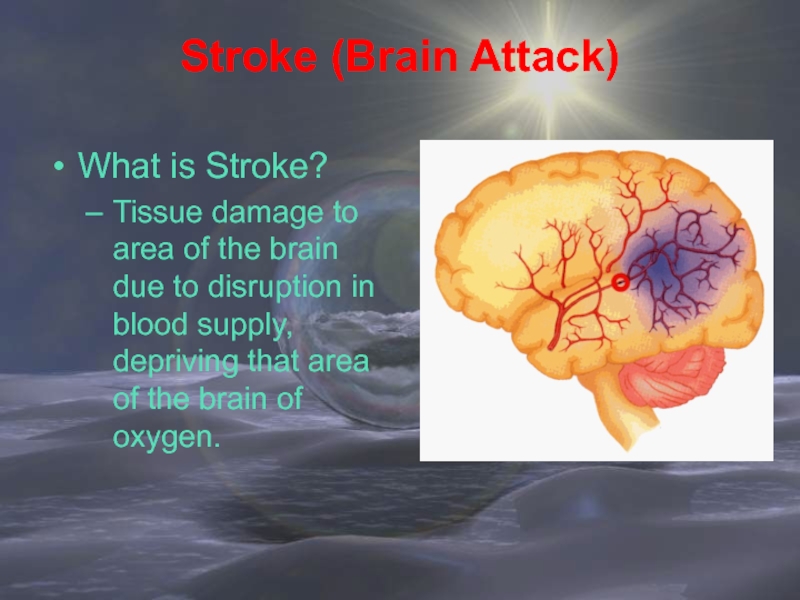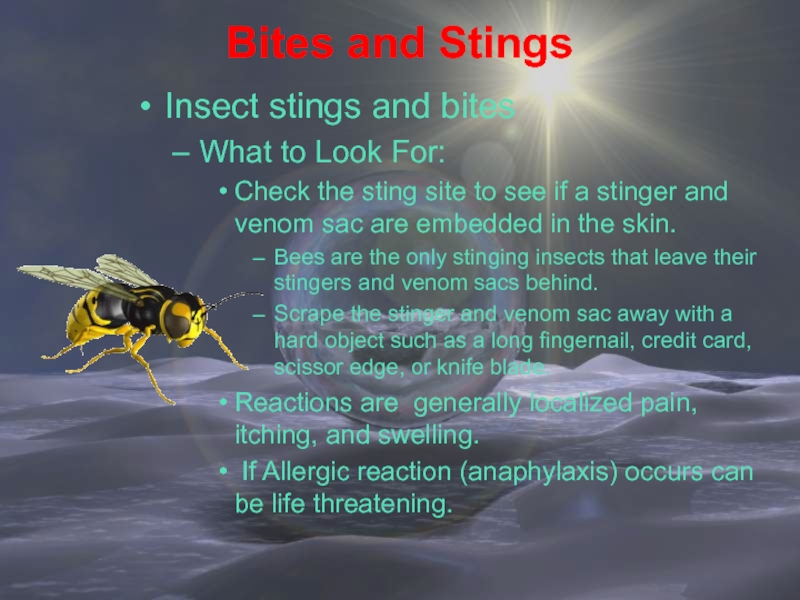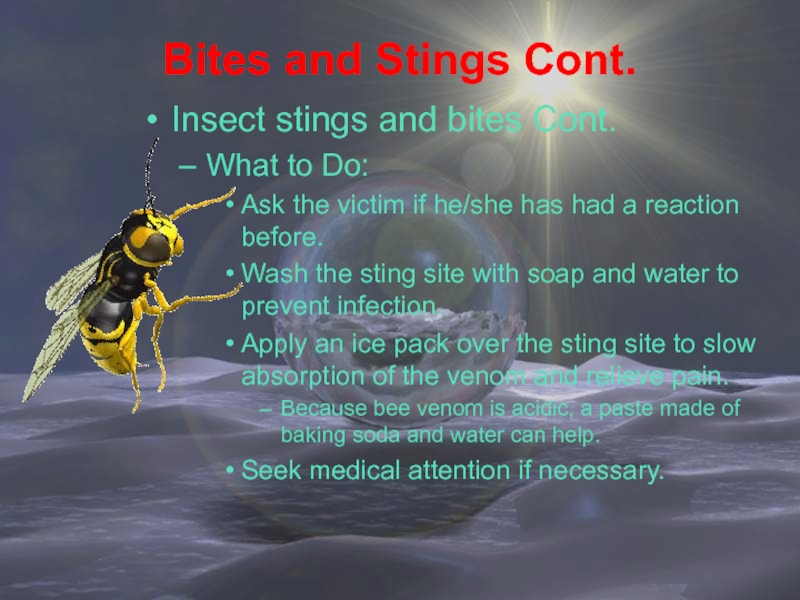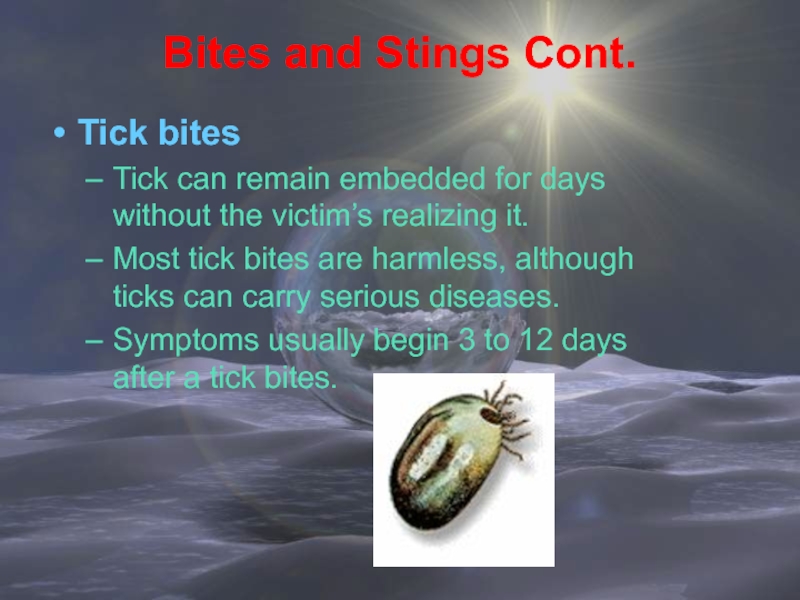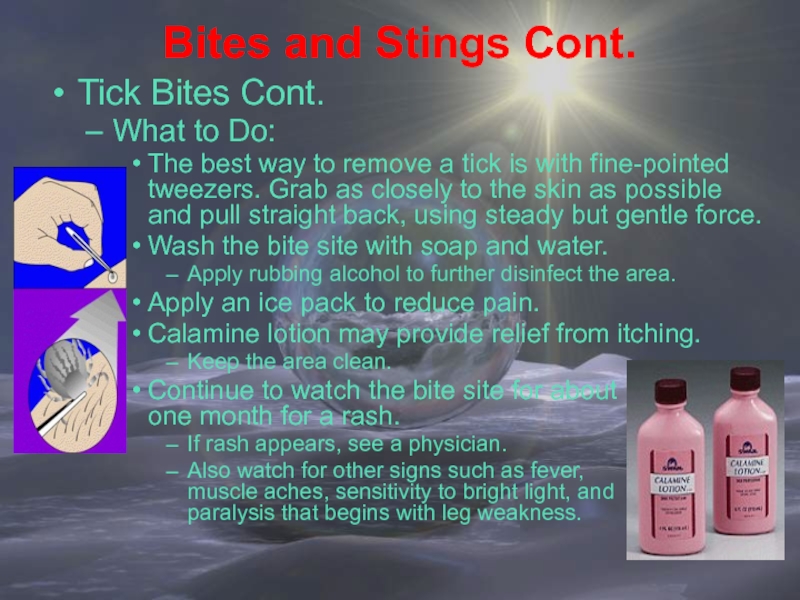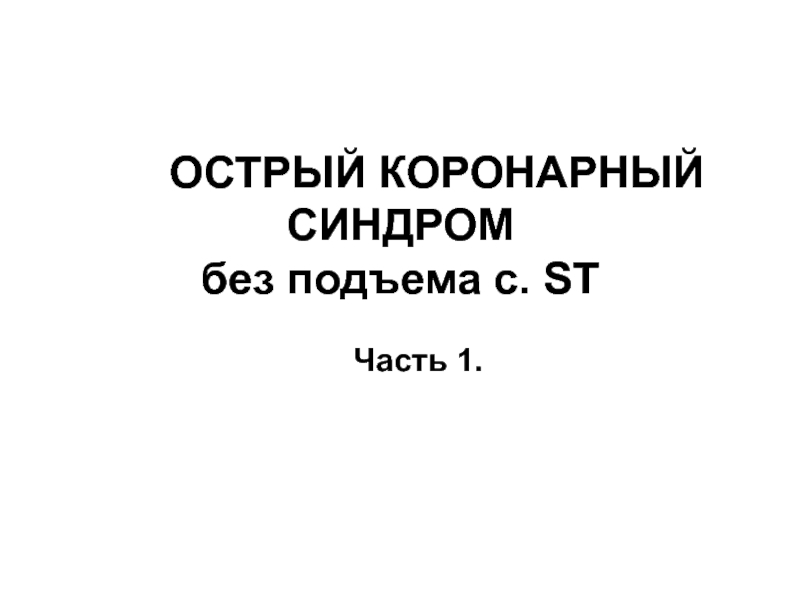- Главная
- Разное
- Дизайн
- Бизнес и предпринимательство
- Аналитика
- Образование
- Развлечения
- Красота и здоровье
- Финансы
- Государство
- Путешествия
- Спорт
- Недвижимость
- Армия
- Графика
- Культурология
- Еда и кулинария
- Лингвистика
- Английский язык
- Астрономия
- Алгебра
- Биология
- География
- Детские презентации
- Информатика
- История
- Литература
- Маркетинг
- Математика
- Медицина
- Менеджмент
- Музыка
- МХК
- Немецкий язык
- ОБЖ
- Обществознание
- Окружающий мир
- Педагогика
- Русский язык
- Технология
- Физика
- Философия
- Химия
- Шаблоны, картинки для презентаций
- Экология
- Экономика
- Юриспруденция
Basic First Aid. Facilities Planning & Management презентация
Содержание
- 1. Basic First Aid. Facilities Planning & Management
- 2. Chain of Survival In order for
- 3. Basic First Aid What Is First
- 4. Scene Survey When confronted with an
- 5. Initial Assessment Goal of the initial
- 6. Victim Assessment Sequence Assessment Sequence Components:
- 7. Bleeding Control Control Methods For External
- 8. Bleeding Control Cont. Control Methods For
- 9. Shock Shock refers to circulatory system
- 10. Shock Cont. What to Look For
- 11. Shock Cont. What to Do After
- 12. Burns Burn injuries can be classified
- 13. Facilities Planning & Management UW-Eau Claire Burns
- 14. Burns Cont. What to Do: Remove
- 15. Burns Burns have been described as:
- 16. First Degree Burns
- 17. Burns Cont. Second-degree burns (Partial Thickness)
- 18. Second Degree Burns
- 19. Burns Cont. Third-degree burns (Full Thickness)
- 20. Third Degree Burns
- 21. Burns Cont. Electrical Burns A mild
- 22. Burns Cont. What to Do: Make
- 23. Choking What is it? Obstruction in
- 24. Choking Cont. What to Do: Perform
- 25. Choking Cont. What to Do: Unconscious
- 26. Fractures There are two categories of
- 28. Fractures Cont. What to Look for:
- 29. Signs and Symptoms of Injury 14-
- 30. Fractures Cont. Additional signs and symptoms
- 31. Foreign Body in the Eye Eye
- 32. Basic First Aid for Wounds Open
- 33. Basic First Aid for Wounds Cont.
- 34. Basic First Aid for Wounds Cont.
- 35. Basic First Aid for Wounds Cont.
- 36. Basic First Aid for Wounds Cont.
- 37. Dressings and Bandages The purpose of
- 38. Dressings and Bandages Cont. Bandage can
- 39. Amputation What to Do: Control the
- 40. External Bleeding If an adult looses more
- 41. Checking for Spinal Injuries Spinal Injuries
- 42. Checking for Spinal Injuries Cont. What
- 43. Checking for Spinal Injuries Cont. Responsive
- 44. Stroke (Brain Attack) What is Stroke?
- 45. Stroke (Brain Attack) Cont. Signs and
- 46. Bites and Stings Insect stings and
- 47. Bites and Stings Cont. Insect stings
- 48. Bites and Stings Cont. Tick bites
- 49. Bites and Stings Cont. Tick Bites
Слайд 2
Chain of Survival
In order for a person to survive
Early
Access “112”
Early
First Aid/CPR
You
Early
Defibrillation
EMS
on
Scene
Scene
Early
Advanced Care
Hospital
Слайд 3
Basic First Aid
What Is First Aid?
The immediate care given to an
injured or suddenly ill person.
DOES NOT take the place of proper medical treatment.
Legal Considerations
Implied Consent involves an unresponsive victim in a life-threatening condition.
It is assumed or “implied” that an unresponsive victim would consent to lifesaving help.
Only perform First Aid assistance for which you have been trained.
DOES NOT take the place of proper medical treatment.
Legal Considerations
Implied Consent involves an unresponsive victim in a life-threatening condition.
It is assumed or “implied” that an unresponsive victim would consent to lifesaving help.
Only perform First Aid assistance for which you have been trained.
Слайд 4
Scene Survey
When confronted with an accident or illness on duty it
is important to assess the situation to determine what kind of emergency situation you are dealing with, for your safety, the victim’s safety and that of others.
Do a quick survey of the scene that includes looking for three elements:
Hazards that could be dangerous to you, the victim, or bystanders.
The cause (mechanism) of the injury or illness.
The number of victims.
Note: This survey should only take a few seconds.
Do a quick survey of the scene that includes looking for three elements:
Hazards that could be dangerous to you, the victim, or bystanders.
The cause (mechanism) of the injury or illness.
The number of victims.
Note: This survey should only take a few seconds.
Слайд 5
Initial Assessment
Goal of the initial assessment:
Visually determine whether there are life-threatening
or other serious problems that require quick care.
Determine if victim is conscious - by tap and shout. Check for ABC as indicated:
A = Airway Open? – Head-tilt/Chin-lift.
B = Breathing? – Look, listen, and feel.
C = Circulation? – Check for signs of circulation.
Note: These step-by-step initial assessment should not be changed. It takes less than a minute to complete, unless first aid is required at any point.
Determine if victim is conscious - by tap and shout. Check for ABC as indicated:
A = Airway Open? – Head-tilt/Chin-lift.
B = Breathing? – Look, listen, and feel.
C = Circulation? – Check for signs of circulation.
Note: These step-by-step initial assessment should not be changed. It takes less than a minute to complete, unless first aid is required at any point.
Breathing
Bleeding
Shock
Burn
Choking
Heart Attack
Fractures
Слайд 6
Victim Assessment Sequence
Assessment Sequence Components:
If victim is responsive
Ask them what injuries
or difficulties they are experiencing.
Check and provide first aid for these complaints as well as others that may be involved.
If victim is not responsive (Unconscious or incoherent).
Observe for obvious signs of injury or illness:
Check from head to toe
Provide first aid/CPR for injuries or illness observed.
Check and provide first aid for these complaints as well as others that may be involved.
If victim is not responsive (Unconscious or incoherent).
Observe for obvious signs of injury or illness:
Check from head to toe
Provide first aid/CPR for injuries or illness observed.
Слайд 7
Bleeding Control
Control Methods For External Bleeding:
Direct pressure stops most bleeding.
Wear medical
exam gloves (if possible)
Place a sterile gauze pad or a clean cloth over wound
Elevation injured part to help reduce blood flow.
Combine with direct pressure over the wound (this will allow you to attend to other injuries or victims).
If bleeding continues, apply pressure at a pressure point to slow blood flow.
Pressure point locations:
Brachial (Top of elbow)
Femoral (Inside upper thigh)
Place a sterile gauze pad or a clean cloth over wound
Elevation injured part to help reduce blood flow.
Combine with direct pressure over the wound (this will allow you to attend to other injuries or victims).
If bleeding continues, apply pressure at a pressure point to slow blood flow.
Pressure point locations:
Brachial (Top of elbow)
Femoral (Inside upper thigh)
Слайд 8
Bleeding Control Cont.
Control Methods For Internal Bleeding:
Signs of internal bleeding:
Bruises or
contusions of the skin
Painful, tender, rigid, bruised abdomen
Vomiting or coughing up blood
Stools that are black or contain bright red blood
What to Do:
For severe internal bleeding, follow these steps:
Monitor ABC’s (Airway Breathing Circulation)
Keep the victim lying on his/her left side. (This will help prevent expulsion of vomit from stomach, or allow the vomit to drain and also prevent the victim from inhaling vomit).
Treat for shock by raising the victim’s legs 8” – 12”
Seek immediate medical attention
Painful, tender, rigid, bruised abdomen
Vomiting or coughing up blood
Stools that are black or contain bright red blood
What to Do:
For severe internal bleeding, follow these steps:
Monitor ABC’s (Airway Breathing Circulation)
Keep the victim lying on his/her left side. (This will help prevent expulsion of vomit from stomach, or allow the vomit to drain and also prevent the victim from inhaling vomit).
Treat for shock by raising the victim’s legs 8” – 12”
Seek immediate medical attention
Слайд 9
Shock
Shock refers to circulatory system failure that happens when insufficient amounts
of oxygenated blood is provided for every body part. This can be as the result of:
Loss of blood due to uncontrolled bleeding or other circulatory system problem.
Loss of fluid due to dehydration or excessive sweating.
Trauma (injury)
Occurrence of an extreme emotional event.
Loss of blood due to uncontrolled bleeding or other circulatory system problem.
Loss of fluid due to dehydration or excessive sweating.
Trauma (injury)
Occurrence of an extreme emotional event.
Слайд 10
Shock Cont.
What to Look For
Altered mental status
Anxiety and restlessness
Pale, cold, and
clammy skin, lips, and nail beds
Nausea and vomiting
Rapid breathing and pulse
Unresponsiveness when shock is severe
Nausea and vomiting
Rapid breathing and pulse
Unresponsiveness when shock is severe
Слайд 11
Shock Cont.
What to Do
After first treating life-threatening injuries such as breathing
or bleeding, the following procedures shall be performed:
Lay the victim on his or her back
Raise the victim’s legs 8” – 12” to allow the blood to drain from the legs back to the heart.
Prevent body heat loss by putting blankets and coats under and over the victim
Lay the victim on his or her back
Raise the victim’s legs 8” – 12” to allow the blood to drain from the legs back to the heart.
Prevent body heat loss by putting blankets and coats under and over the victim
Слайд 12
Burns
Burn injuries can be classified as follow:
Thermal (heat) burns caused by:
Flames
Hot
objects
Flammable vapor that ignites
Steam or hot liquid
What to Do:
Stop the burning
Remove victim from burn source
If open flame, smother with blanket, coat or similar item, or have the victim roll on ground.
Determine the depth (degree) of the burn
Flammable vapor that ignites
Steam or hot liquid
What to Do:
Stop the burning
Remove victim from burn source
If open flame, smother with blanket, coat or similar item, or have the victim roll on ground.
Determine the depth (degree) of the burn
Слайд 13Facilities Planning & Management
UW-Eau Claire
Burns Cont.
Chemical burns
The result of a caustic
or corrosive substance touching the skin caused by:
Acids (batteries)
Alkalis (drain cleaners- often more extensive)
Organic compounds (oil products)
Acids (batteries)
Alkalis (drain cleaners- often more extensive)
Organic compounds (oil products)
Слайд 14
Burns Cont.
What to Do:
Remove the chemical by flushing the area with
water
Brush dry powder chemicals from the skin before flushing
Take precautions to protect yourself from exposure to the chemical
Remove the victim’s contaminated clothing and jewelry while flushing with water
Flush for 20 minutes all chemical burns (skin, eyes)
Cover the burned area with a dry, sterile dressing
Seek medical attention
Brush dry powder chemicals from the skin before flushing
Take precautions to protect yourself from exposure to the chemical
Remove the victim’s contaminated clothing and jewelry while flushing with water
Flush for 20 minutes all chemical burns (skin, eyes)
Cover the burned area with a dry, sterile dressing
Seek medical attention
Слайд 15
Burns
Burns have been described as:
First-degree burns (Superficial)
Only the skin’s outer layer
(epidermis) is damaged.
Symptoms include redness, mild swelling, tenderness, and pain.
Usually heals without scarring.
What to Do:
Immerse in cold water 10 to 45 minutes or use cold, wet cloths.
Cold stops burn progression
May use other liquids
Aloe, moisturizer lotion
Symptoms include redness, mild swelling, tenderness, and pain.
Usually heals without scarring.
What to Do:
Immerse in cold water 10 to 45 minutes or use cold, wet cloths.
Cold stops burn progression
May use other liquids
Aloe, moisturizer lotion
Слайд 17
Burns Cont.
Second-degree burns (Partial Thickness)
Epidermis and upper regions of
dermis are damaged.
Symptoms include blisters, swelling, weeping of fluids, and severe pain.
What to Do:
Immerse in cold water / wet pack
Aspirin or ibuprofen
Do not break blisters
May seek medical attention
Symptoms include blisters, swelling, weeping of fluids, and severe pain.
What to Do:
Immerse in cold water / wet pack
Aspirin or ibuprofen
Do not break blisters
May seek medical attention
Слайд 19
Burns Cont.
Third-degree burns (Full Thickness)
Severe burns that penetrate all the skin
layers, into the underlying fat and muscle.
Symptoms include: the burned area appears gray-white, cherry red, or black; there is no initial edema or pain (since nerve endings are destroyed)
What to Do:
Usually not necessary to apply cold to areas of third degree
Do not apply ointments
Apply sterile, non-stick dressings (do not use plastic)
Check ABC’s
Treat for shock
Get medical help
Symptoms include: the burned area appears gray-white, cherry red, or black; there is no initial edema or pain (since nerve endings are destroyed)
What to Do:
Usually not necessary to apply cold to areas of third degree
Do not apply ointments
Apply sterile, non-stick dressings (do not use plastic)
Check ABC’s
Treat for shock
Get medical help
Слайд 21
Burns Cont.
Electrical Burns
A mild electrical shock can
cause serious internal injuries.
There are three types of electrical injuries:
Thermal burn (flame) – Objects in direct contact with the skin are ignited by an electrical current.
Mostly caused by the flames produced by the electrical current and not by the passage of the electrical current or arc.
Arc burn (Flash) – Occurs when electricity jumps, or arcs, from one spot to another.
Mostly cause extensive superficial injuries.
True Electrical Injury (contact) – Occurs when an electric current truly passes through the body.
There are three types of electrical injuries:
Thermal burn (flame) – Objects in direct contact with the skin are ignited by an electrical current.
Mostly caused by the flames produced by the electrical current and not by the passage of the electrical current or arc.
Arc burn (Flash) – Occurs when electricity jumps, or arcs, from one spot to another.
Mostly cause extensive superficial injuries.
True Electrical Injury (contact) – Occurs when an electric current truly passes through the body.
Слайд 22
Burns Cont.
What to Do:
Make sure the scene is safe
Unplug, disconnect, or
turn off the power.
If that is impossible, call the power company or EMS for help.
Do not contact high voltage wires
Consider all wires live
Do not handle downed lines
Do not come in contact with person if the electrical source is live
Check ABCs. (Airway Breathing Circulation)
If the victim fell, check for a spinal injury.
Treat the victim for shock by elevating the legs 8” – 12” if no spinal injury is suspected.
Seek medical attention immediately.
If that is impossible, call the power company or EMS for help.
Do not contact high voltage wires
Consider all wires live
Do not handle downed lines
Do not come in contact with person if the electrical source is live
Check ABCs. (Airway Breathing Circulation)
If the victim fell, check for a spinal injury.
Treat the victim for shock by elevating the legs 8” – 12” if no spinal injury is suspected.
Seek medical attention immediately.
Слайд 23
Choking
What is it?
Obstruction in the airway.
General Precaution
If someone is coughing, leave
the person alone.
Do not perform the Heimlich Maneuver.
Keep eyes on that person.
Ask the person if he/she needs help.
Signs and Symptoms
Person is not able to breath or talk due to obstruction, choking sign given, distressed, and panic.
Hands wrapped around the neck is universal sign for choking.
Do not perform the Heimlich Maneuver.
Keep eyes on that person.
Ask the person if he/she needs help.
Signs and Symptoms
Person is not able to breath or talk due to obstruction, choking sign given, distressed, and panic.
Hands wrapped around the neck is universal sign for choking.
Слайд 24
Choking Cont.
What to Do:
Perform Heimlich Maneuver if
you are properly trained
Conscious Victim:
Approach from behind and wrap arms around the victim’s waist.
Place one fist just above the victim’s navel with the thumb side against the abdomen.
Second hand over the fist.
Press into the victim’s abdomen with one upward thrust
Repeat thrust if necessary.
Try to pop the obstruction out with swift thrusts in and up.
Continue until the obstruction is relieved or victim collapses.
Have someone call for help.
Note: Always stay calm.
Conscious Victim:
Approach from behind and wrap arms around the victim’s waist.
Place one fist just above the victim’s navel with the thumb side against the abdomen.
Second hand over the fist.
Press into the victim’s abdomen with one upward thrust
Repeat thrust if necessary.
Try to pop the obstruction out with swift thrusts in and up.
Continue until the obstruction is relieved or victim collapses.
Have someone call for help.
Note: Always stay calm.
Слайд 25
Choking Cont.
What to Do:
Unconscious Victim:
Ask someone to call 112 for
help
Lower victim to floor on back or left side and perform Heimlich Maneuver
Open airway with tongue-jaw lift
Look inside mouth – if you cannot see anything, do a finger sweep
Try to give two full rescue breaths
If these do not go in, reposition the head and give another breath
Perform abdominal thrusts
Continue until successful or help arrives
Lower victim to floor on back or left side and perform Heimlich Maneuver
Open airway with tongue-jaw lift
Look inside mouth – if you cannot see anything, do a finger sweep
Try to give two full rescue breaths
If these do not go in, reposition the head and give another breath
Perform abdominal thrusts
Continue until successful or help arrives
Слайд 26
Fractures
There are two categories of fractures:
Closed (Simple) fracture
The skin is intact
and no wound exists anywhere near the fracture site.
Open (Compound) fracture
The skin over the fracture has been damaged or broken.
The wound may result from bone protruding through the skin.
The bone may not always be visible in the wound.
Open (Compound) fracture
The skin over the fracture has been damaged or broken.
The wound may result from bone protruding through the skin.
The bone may not always be visible in the wound.
Слайд 28
Fractures Cont.
What to Look for:
General signs and Symptoms:
Tenderness to touch.
Swelling.
Deformities
may occur when bones are broken, causing an abnormal shape.
Open wounds break the skin.
A grating sensation caused by broken bones rubbing together
can be felt and sometimes even heard.
Do not move the injured limb in an attempt to detect it.
Loss of use.
Open wounds break the skin.
A grating sensation caused by broken bones rubbing together
can be felt and sometimes even heard.
Do not move the injured limb in an attempt to detect it.
Loss of use.
Слайд 30
Fractures Cont.
Additional signs and symptoms include:
The history of the injury can
lead to suspect a fracture whenever a serious accident has happened.
The victim may have heard or felt the bone snap.
The victim may have heard or felt the bone snap.
Слайд 31Foreign Body in the Eye
Eye
When on the pupil or embedded
in the white of the eye
Never try to remove the object
Cover the injured eye with a clean pad
Bandage both eyes
Take the victim to the hospital
When floating on the white of the eye
Advise the victim not to rub the eye
Have them sit down facing a light so that you can see into the eye clearly
Using your finger or thumb gently pull the eyelids of the injured eye apart
When you see the foreign body wash it out with clean water
If the foreign body has not moved, try to lift it off with a moist swab or the dampened corner of a tissue or handkerchief.
Never try to remove the object
Cover the injured eye with a clean pad
Bandage both eyes
Take the victim to the hospital
When floating on the white of the eye
Advise the victim not to rub the eye
Have them sit down facing a light so that you can see into the eye clearly
Using your finger or thumb gently pull the eyelids of the injured eye apart
When you see the foreign body wash it out with clean water
If the foreign body has not moved, try to lift it off with a moist swab or the dampened corner of a tissue or handkerchief.
Слайд 32
Basic First Aid for Wounds
Open Wounds
A break in the skin’s surface
that results in external bleeding and may allow bacteria to enter the body that can cause infection
Abrasion
The top layer of skin is removed with little or no blood loss
Scrape
Laceration
A cut skin with jagged, irregular edges and caused by a forceful tearing away of skin tissue
Incisions
Smooth edges and resemble a surgical or paper cut
Abrasion
The top layer of skin is removed with little or no blood loss
Scrape
Laceration
A cut skin with jagged, irregular edges and caused by a forceful tearing away of skin tissue
Incisions
Smooth edges and resemble a surgical or paper cut
Слайд 33
Basic First Aid for Wounds Cont.
Open Wounds Cont.
Punctures
Deep, narrow wounds such
as a stab wound from a nail or a knife in the skin and underlying organs
Avulsion
Flap of skin is torn loose and is either hanging from the body or completely removed
Amputation
Cutting or tearing off of a body part such as a finger, toe, hand, foot, arm, or leg
Avulsion
Flap of skin is torn loose and is either hanging from the body or completely removed
Amputation
Cutting or tearing off of a body part such as a finger, toe, hand, foot, arm, or leg
Слайд 34
Basic First Aid for Wounds Cont.
What to Do:
Wear gloves (if possible)
and expose wound
Control bleeding
Clean wounds
To prevent infection
Wash shallow wound gently with soap and water
Wash from the center out / Irrigate with water
Severe wound?
Clean only after bleeding has stopped
Control bleeding
Clean wounds
To prevent infection
Wash shallow wound gently with soap and water
Wash from the center out / Irrigate with water
Severe wound?
Clean only after bleeding has stopped
Слайд 35
Basic First Aid for Wounds Cont.
Wounds Care
Remove small objects that do
not flush out by irrigation with sterile tweezers.
If bleeding restarts, apply direct pressure.
Use roller bandages (or tape dressing to the body)
Keep dressings dry and clean
Change the dressing if it gets wet or dirty.
If bleeding restarts, apply direct pressure.
Use roller bandages (or tape dressing to the body)
Keep dressings dry and clean
Change the dressing if it gets wet or dirty.
Слайд 36
Basic First Aid for Wounds Cont.
Signs of Wound Infection:
Swelling, and redness
around the wound
A sensation of warmth
Throbbing pain
Fever / chills
Swollen lymph nodes
Red streaks
Tetanus (lock jaw), should receive injection in first 72 hours.
A sensation of warmth
Throbbing pain
Fever / chills
Swollen lymph nodes
Red streaks
Tetanus (lock jaw), should receive injection in first 72 hours.
Слайд 37
Dressings and Bandages
The purpose of a dressing is to:
Control bleeding
Prevent infection
and contamination
Absorb blood and fluid drainage
Protect the wound from further injury
What to Do:
Always wear gloves (if possible)
Use a dressing large enough to extend beyond the wound’s edges.
Cover the dressing with bandages.
Absorb blood and fluid drainage
Protect the wound from further injury
What to Do:
Always wear gloves (if possible)
Use a dressing large enough to extend beyond the wound’s edges.
Cover the dressing with bandages.
Слайд 38
Dressings and Bandages Cont.
Bandage can be used to:
Hold a dressing in
place over an open wound
Apply direct pressure over a dressing to control bleeding
Prevent or reduce swelling
Provide support and stability for an extremity or joint
Bandage should be clean but need not be sterile.
Apply direct pressure over a dressing to control bleeding
Prevent or reduce swelling
Provide support and stability for an extremity or joint
Bandage should be clean but need not be sterile.
Слайд 39
Amputation
What to Do:
Control the bleeding
Treat the victim for shock
Recover the amputated
part and whenever possible take it with the victim
To care for the amputated body part:
The amputated part does not need to be cleaned
Wrap the amputated part with a dry sterile gauze or other clean cloth
Put the wrapped amputated part in a plastic bag or other waterproof container
Keep the amputated part cool, but do not freeze
Place the bag or container with the wrapped part on a bed of ice
Seek medical attention immediately
To care for the amputated body part:
The amputated part does not need to be cleaned
Wrap the amputated part with a dry sterile gauze or other clean cloth
Put the wrapped amputated part in a plastic bag or other waterproof container
Keep the amputated part cool, but do not freeze
Place the bag or container with the wrapped part on a bed of ice
Seek medical attention immediately
Слайд 40External Bleeding
If an adult looses more than 1 liter of blood
or a child looses as little as 1/3 of that amount loss is considered severe.
Слайд 41
Checking for Spinal Injuries
Spinal Injuries
Head injuries may indicate that there are
possible spinal injuries
It may have been moved suddenly in one or more directions, damaging the spine.
What to Look For
General signs & symptoms
Painful movement of the arms or legs
Numbness, tingling, weakness, or burning sensation in the arms or legs
Loss of bowel or bladder control
Paralysis of the arms or legs
Deformity (odd-looking angle of the victim’s head & neck
It may have been moved suddenly in one or more directions, damaging the spine.
What to Look For
General signs & symptoms
Painful movement of the arms or legs
Numbness, tingling, weakness, or burning sensation in the arms or legs
Loss of bowel or bladder control
Paralysis of the arms or legs
Deformity (odd-looking angle of the victim’s head & neck
Слайд 42
Checking for Spinal Injuries Cont.
What to Do:
Stabilize the victim against any
movement.
Check ABCs. (Airway Breathing Circulation)
Unresponsive Victim:
Look for cuts, bruise, and deformities.
Test response by pinching the victim’s hand, and bare foot.
If no reaction, assume the victim may have spinal damage.
Check ABCs. (Airway Breathing Circulation)
Unresponsive Victim:
Look for cuts, bruise, and deformities.
Test response by pinching the victim’s hand, and bare foot.
If no reaction, assume the victim may have spinal damage.
Слайд 43
Checking for Spinal Injuries Cont.
Responsive Victim
Upper Extremity Checks:
Victim wiggles fingers.
Victim feels
rescuer squeeze fingers.
Victim squeeze rescuer’s hand.
Lower Extremity Checks:
Victim wiggles toes.
Victim feels rescuer squeezes toes.
Victim pushes foot against rescuer’s hand.
Victim squeeze rescuer’s hand.
Lower Extremity Checks:
Victim wiggles toes.
Victim feels rescuer squeezes toes.
Victim pushes foot against rescuer’s hand.
Слайд 44
Stroke (Brain Attack)
What is Stroke?
Tissue damage to area of the brain
due to disruption in blood supply, depriving that area of the brain of oxygen.
Слайд 45
Stroke (Brain Attack) Cont.
Signs and Symptoms of Stroke:
Weakness or numbness of
the face, arm, or leg (usually on one side of the body)
Blurred or decreased vision, especially in one eye.
Problems speaking or understanding
Unexplained, severe headache
Dizziness, unsteadiness, or sudden fall
Blurred or decreased vision, especially in one eye.
Problems speaking or understanding
Unexplained, severe headache
Dizziness, unsteadiness, or sudden fall
Слайд 46
Bites and Stings
Insect stings and bites
What to Look For:
Check the sting
site to see if a stinger and venom sac are embedded in the skin.
Bees are the only stinging insects that leave their stingers and venom sacs behind.
Scrape the stinger and venom sac away with a hard object such as a long fingernail, credit card, scissor edge, or knife blade.
Reactions are generally localized pain, itching, and swelling.
If Allergic reaction (anaphylaxis) occurs can be life threatening.
Bees are the only stinging insects that leave their stingers and venom sacs behind.
Scrape the stinger and venom sac away with a hard object such as a long fingernail, credit card, scissor edge, or knife blade.
Reactions are generally localized pain, itching, and swelling.
If Allergic reaction (anaphylaxis) occurs can be life threatening.
Слайд 47
Bites and Stings Cont.
Insect stings and bites Cont.
What to Do:
Ask the
victim if he/she has had a reaction before.
Wash the sting site with soap and water to prevent infection.
Apply an ice pack over the sting site to slow absorption of the venom and relieve pain.
Because bee venom is acidic, a paste made of baking soda and water can help.
Seek medical attention if necessary.
Wash the sting site with soap and water to prevent infection.
Apply an ice pack over the sting site to slow absorption of the venom and relieve pain.
Because bee venom is acidic, a paste made of baking soda and water can help.
Seek medical attention if necessary.
Слайд 48
Bites and Stings Cont.
Tick bites
Tick can remain embedded for days without
the victim’s realizing it.
Most tick bites are harmless, although ticks can carry serious diseases.
Symptoms usually begin 3 to 12 days after a tick bites.
Most tick bites are harmless, although ticks can carry serious diseases.
Symptoms usually begin 3 to 12 days after a tick bites.
Слайд 49
Bites and Stings Cont.
Tick Bites Cont.
What to Do:
The best way to
remove a tick is with fine-pointed tweezers. Grab as closely to the skin as possible and pull straight back, using steady but gentle force.
Wash the bite site with soap and water.
Apply rubbing alcohol to further disinfect the area.
Apply an ice pack to reduce pain.
Calamine lotion may provide relief from itching.
Keep the area clean.
Continue to watch the bite site for about one month for a rash.
If rash appears, see a physician.
Also watch for other signs such as fever, muscle aches, sensitivity to bright light, and paralysis that begins with leg weakness.
Wash the bite site with soap and water.
Apply rubbing alcohol to further disinfect the area.
Apply an ice pack to reduce pain.
Calamine lotion may provide relief from itching.
Keep the area clean.
Continue to watch the bite site for about one month for a rash.
If rash appears, see a physician.
Also watch for other signs such as fever, muscle aches, sensitivity to bright light, and paralysis that begins with leg weakness.

